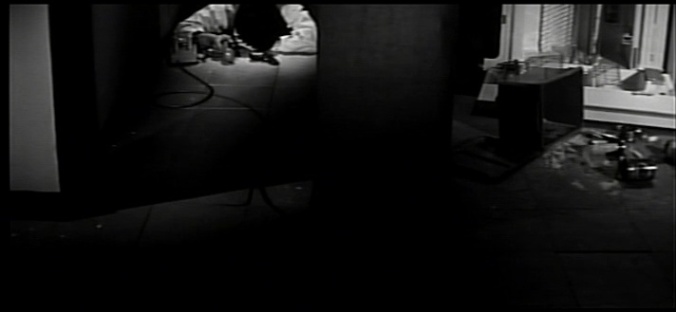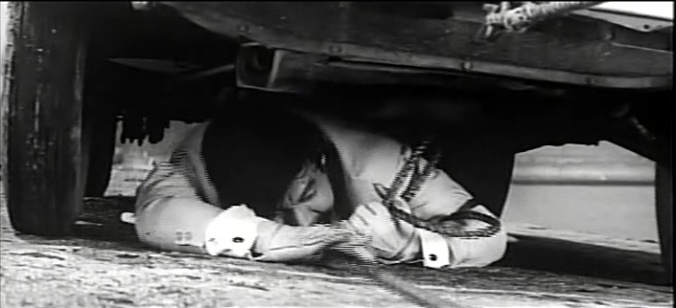 Such a powerful mythology has grown around Branded to Kill that it may take me several posts to discuss it. Here, I’d like to try to talk about it as if I had only just seen it.
Such a powerful mythology has grown around Branded to Kill that it may take me several posts to discuss it. Here, I’d like to try to talk about it as if I had only just seen it.
Obviously, it is a hitman movie, which Japan seems to have invented and then forgotten about until the rest of the world caught up. The hit man with the rifle in the window first appeared in Japan in A Colt Is My Passport, but the idea of a ranking for hit men and a battle to determine who should be #1 can be traced back at least to Killers on Parade, where no one uses a rifle and the whole thing is treated as a joke. Here it is treated seriously in the script, but Suzuki himself seemed to think it was too absurd to hold up in the straightforward manner of his earlier crime and yakuza movies and decided to liven it up in any way that came to mind. The studio boss thought the movie was incomprehensible and fired Suzuki, but, despite all the visual gimmicky, there is no trouble following the plot. Taking it seriously is a different issue.
The plot of Branded to Kill is unusually straightforward for a Nikkatsu B-movie, especially considering it had at least four screenwriters, not to mention what Suzuki himself may have added. Hanada (Jo Shishido) is the #3 hitman (who makes these rankings is never explained). He is hired by a buddy who has lost his nerve to bodyguard an unknown man on a trip. They are ambushed and, in a shootout to make any Western fan happy, Hanada’s charge is safely delivered and #2 is killed in the process. Hanada is then hired to kill four more men, but he misses the fourth because a butterfly lands on the barrel as he is firing, slightly altering the trajectory and accidentally killing a bystander. For this failure, orders go out to have him killed, and attempts are made by his wife Mami (Mariko Ogawa), who is also having an affair with the man who hired him, an exotic beauty Misako (Annu Mari) that he falls in love with, and by a gang on a pier. Eventually, no one is left but #1 (Koji Nanbura) himself, who launches a psychological war with Hanada that eventually finds them living together and even handcuffed together before their final duel.
One interesting aspect to me is how much of the movie is a chanbara in modern dress. While there is a lot of talk about Hanada’s ranking as they are driving their passenger, he is at this point simply a yojimbo, a ronin bodyguard, who has wandered into someone else’s problem. His skill is then demonstrated by a massive fight, this time with gun rather than sword. Things then appear to calm down as he finds a woman or two who are interested in him, until by accident he kills the wrong person, leading to a long attempt at revenge on him before at last, after eliminating the gang, he must face one-to-one the quiet ronin who has been always lurking in the shadows. In structure, it is a Zatoichi movie.
Of course, it doesn’t look like a Zatoichi movie at all or like any other movie that comes to mind. The first part of the movie, with the strange passenger and the giant shoot-out, could have been made by anyone at any time from the mid-thirties till the present day. Once the shootout is over, however, we enter the territory for which Suzuki is famous. In other words, things seem to go increasingly insane. But we don’t go insane in the usual Nikkatsu manner. There is no nightclub scene, for example, and though we have a pop star sing the title ballad, we never see him on screen. The movie stays almost completely with Hanada and some of the insane aspects of the film can be interpreted as illustrations of Hanada’s gradual descent into madness. It is not always clear when he is seeing Misako and when he is hallucinating her. 
 Later, when he is trapped in his apartment, both hunted and taunted by #1, the camera almost loses sight of him, little more than his head appearing at the far edges of the frame.
Later, when he is trapped in his apartment, both hunted and taunted by #1, the camera almost loses sight of him, little more than his head appearing at the far edges of the frame.
Still, there is much weirdness before those particular scenes, starting with Hanada’s fetish for the smell of warm rice. Shooting the dentist up the drain of his sink is famous, though impossible in fact (the bullet would have to go around several corners in the pipe to get there). Another shooting is made as the top of a giant advertisement for a cigarette lighter clicks open, then shuts again to hide Hanada. During a later gunfight, Hanada provides cover by pulling the car above him forward with a rope conveniently circling a pulley that allows him to use both ends. When he has finished the big shootout, the car he has stolen breaks down and he is picked up by the mysterious Misako, who drives a convertible with the top down in the rain. The rain continues in numerous shower scenes. He makes passionate love to his wife high on a spiral staircase, possibly the most dangerous sex scene in film.
When he has finished the big shootout, the car he has stolen breaks down and he is picked up by the mysterious Misako, who drives a convertible with the top down in the rain. The rain continues in numerous shower scenes. He makes passionate love to his wife high on a spiral staircase, possibly the most dangerous sex scene in film. Misako’s house is covered with butterflies — not butterfly patterned wallpaper but butterflies stuck to the wall.
Misako’s house is covered with butterflies — not butterfly patterned wallpaper but butterflies stuck to the wall. The rain and the butterflies are almost obsessive motifs in the middle section, with at one point cartoons of them superimposed on the actors, only to disappear in the last third of the movie just as inexplicably as they appeared.
The rain and the butterflies are almost obsessive motifs in the middle section, with at one point cartoons of them superimposed on the actors, only to disappear in the last third of the movie just as inexplicably as they appeared. In opposition to Mizoguchi’s “one scene, one shot” motto, we have something closer to “one shot, one phrase.” Even when the actors are silent, it is rare to go as long as ten seconds in a single shot, and every shot seems to be from a different angle.* At one point, it takes Mami four different shots to finish a single line, and that is only the most obvious example. Though there are no (obvious) flashbacks, we move forward from scene to scene without any clear indication of passage of time, and at one point the cutting is so abrupt that Mami seems to be watching herself have sex with Hanada.
In opposition to Mizoguchi’s “one scene, one shot” motto, we have something closer to “one shot, one phrase.” Even when the actors are silent, it is rare to go as long as ten seconds in a single shot, and every shot seems to be from a different angle.* At one point, it takes Mami four different shots to finish a single line, and that is only the most obvious example. Though there are no (obvious) flashbacks, we move forward from scene to scene without any clear indication of passage of time, and at one point the cutting is so abrupt that Mami seems to be watching herself have sex with Hanada.
In addition to the camera’s extreme unpredictability, Branded to Kill has more nudity than any Japanese movie I’ve seen to this date, far more than Suzuki’s equally famous Gate of Flesh, and more than in a Roger Vadim or Radley Metzger movie of the sixties. Ogawa rarely has her clothes on throughout the entire movie, though a lot of sidelighting and/or long shots keeps the details hazy. Similarly, Maru has a long unconvincing torture scene where the carefully placed hair and shadows shift around but which ends with a shot of her falling uncovered to a glass floor.
Similarly, Maru has a long unconvincing torture scene where the carefully placed hair and shadows shift around but which ends with a shot of her falling uncovered to a glass floor. Like everything else in the movie, these happen fast; there is only one long salacious tour of Maru’s body in the Vadim manner (one of the longest uninterrupted takes in the movie), filmed from the side but with a carefully placed gigantic butterfly to disguise any pubic hair that might stray into the shot.
Like everything else in the movie, these happen fast; there is only one long salacious tour of Maru’s body in the Vadim manner (one of the longest uninterrupted takes in the movie), filmed from the side but with a carefully placed gigantic butterfly to disguise any pubic hair that might stray into the shot.
In an interview I have not been able to retrace, I remember Suzuki saying that all the Nikkatsu scripts were basically the same; he knew what the A feature on the bill would be, so he was just trying to do something to make his feature look different, to get noticed and be given better scripts and better budgets. My memory may not be accurate, and Suzuki was one of the least trustworthy of interviewees, so this should be taken with some care. Nevertheless, if that was his goal here, it backfired, destroying his career. If he was trying to ridicule his material, as others have suggested, that too backfired, because for decades it was the only example of Nikkatsu borderless action movies known in the west.
Ironically, the movie and Suzuki were saved by the studio decision to fire Suzuki. Audiences reportedly did not like it, and had Suzuki continued to work in the shadows, it would have been completely forgotten, waiting patiently for someone in search of a thesis topic. Once he was fired and the film denied to student film societies, it became a cause-celebre. Whatever Suzuki’s purpose, the result has left a delirious piece of film-making that has almost single-handedly placed him in the list of major Japanese movie directors,** though there are other earlier movies directed by him I personally think are better and are still over-shadowed by the reputation and expectations of Branded to Kill. Even after half a century of avant-garde experimentation and changes in film technology, there is still no other movie quite like it.
* If I get a chance, a second post on the movie will deal with this aspect in some detail.
** For just one example, Criterion issued it among its very earliest DVDs in 1998, before even Yojimbo and Sanjuro.
Pingback: Tale of Sorrow / Hishu monogatari (1977) | Japanonfilm
Pingback: Deaths in Tokimeki / Tokimeki ni shisu (1984) | Japanonfilm
Pingback: Bloody Passion / Passion / Aka to kuro no netsujo (1992) | Japanonfilm
Pingback: Getting Any? / Minna yatteruka! / (1994) | Japanonfilm